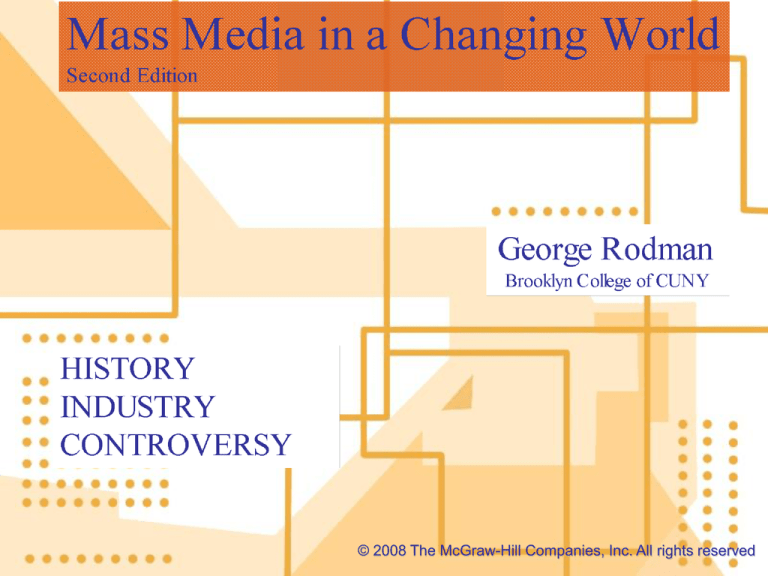
© 2008 The McGraw-Hill Companies, Inc. All rights reserved
Chapter 9
Television: Reflecting and Affecting
Society
Chapter Outline
History
Industry
Controversies
© 2008 The McGraw-Hill Companies, Inc. All rights reserved
A Brief History of Television
• Early Technology
• In 1927, Vladimir Zworykin, a Russian immigrant
working for Westinghouse Corporation, developed a
circuit for transforming a visual image into an
electronic signal.
• Around the same time, Philo T. Farnsworth completed
a working model for a similar system, and applied for
a patent.
• Farnsworth had to endure years of suits and
countersuits before RCA paid him $1 million for the
rights to his patent.
• Inventors in several countries including England,
Japan and Russia, claim to have come up with the idea
of television around the same time.
© 2008 The McGraw-Hill Companies, Inc. All rights reserved
A Brief History of Television
• David Sarnoff of RCA built one of the first
commercial television stations in 1932, with
transmitting facilities in the Empire State
Building, and spent a million dollars
promoting the medium.
• Franklin D. Roosevelt became the first
president to appear on television when he
formally opened the 1939 World’s Fair in
New York.
• Early TV sets did not sell because they were
very expensive, there wasn’t much
programming, and there were no technical
standards.
© 2008 The McGraw-Hill Companies, Inc. All rights reserved
A Brief History of Television
• Development of Technical Standards
• Each manufacturer wanted to reap profits that would
follow if their patents became the broadcast standard.
• Some wanted black and white technology to be the
standard, while others were working on color and
wanted government to wait for it to be perfected.
• Other patents involved different lines of resolution,
those row of lighted dots, or pixels, that make up the
picture image.
• In 1941, government and industry agreed that
television would present black and white pictures with
525 lines of resolution moving at a speed of 30 frames
per second.
© 2008 The McGraw-Hill Companies, Inc. All rights reserved
A Brief History of Television
• World War II Stops TV’s Growth
• Most of the engineers in television joined the military
and developed radar, sonar, radio-guided missiles and
battlefield communications.
• Post-War Development
• In the early 1940s the audience was excited to see any
transmitted picture and the industry broadcast
anything available including talentless talent, live
shots of a sunset and even test patterns.
• By 1948, set sales increased by 500 percent over the
previous year, and viewership grew by 4000 percent.
© 2008 The McGraw-Hill Companies, Inc. All rights reserved
A Brief History of Television
• Channel Allocation
• Channel allocation is the placement of a station’s
frequency on the electromagnetic spectrum used
for transmitting electronic signals.
• The FCC was charged with ensuring that every
community in America would be supplied with at
least one channel, with no overlapping or
interfering channels and, from 1948 to 1952
placed a freeze on license applications in order to
work out the problem.
• During that period the number of sets purchased
rose from a 250,000 to more than 17 million.
© 2008 The McGraw-Hill Companies, Inc. All rights reserved
A Brief History of Television
• The Rise of Network Television
• At first there were four television networks: NBC,
CBS, ABC and Dumont, a network founded by TV
manufacturer Allen B. Dumont who got into
production to increase demand for his sets.
• The Dumont network lacked the radio relationships of
the others and could not line up enough affiliates to be
attractive to advertisers. Dumont folded in 1955. Its
stations went on to become the nucleus of Metromedia
Television, which eventually became the Fox network.
• Stations not connected by cable had to run kinescopes
of network programming.
© 2008 The McGraw-Hill Companies, Inc. All rights reserved
A Brief History of Television
• Television’s Golden Age
• 1948 to 1958 was a time of unusually good dramatic
programming.
• Quality dramas were needed to attract wealthy,
educated viewers who could afford television sets.
• Network programming originated in New York City
and producers had access to up-and-coming Broadway
writers, actors, and directors.
• Most television dramas were performed live because
videotape recording had not been invented yet, and
filming was too expensive.
© 2008 The McGraw-Hill Companies, Inc. All rights reserved
A Brief History of Television
• Many critics point out that TV had more lowest
common denominator content than quality shows.
• “I Love Lucy,” “Father Knows Best” and “Ozzie
and Harriet” featured women who were either
humorously incompetent or subordinate to men who
made all important decisions.
• Virtually all the playwrights, producers, actors, and
directors of the live dramas were white. Minorities
were systematically excluded from production jobs.
• The 1980s success of the Cosby show opened the
door for more black oriented programming with
black production staffs.
© 2008 The McGraw-Hill Companies, Inc. All rights reserved
A Brief History of Television
• The Entrance of the Movie Studios
• In 1954 Walt Disney was the first studio leader to
associate his name with a television program. In an
early example of horizontal integration, Disney saw
the possibilities of TV for promoting his Disneyland
theme park and his feature films, as well as generating
income from the program itself.
• After Warner Brothers began producing the western
“Cheyenne” for ABC in 1955, all the major film
studios started producing television programming as
well as feature films.
© 2008 The McGraw-Hill Companies, Inc. All rights reserved
A Brief History of Television
• Television Changes Family Life
• Television continued the social trends that radio had
started: bringing the American family indoors to
experience programming together, but actually
interacting less in the time they spent together.
• Families didn’t talk during prime-time programs; they
talked among themselves and among outsiders about
what they’d seen on television the night before.
• “Camel Cavalcade of News” (1948-1956) with John
Cameron Swayze is considered the father of television
news.
© 2008 The McGraw-Hill Companies, Inc. All rights reserved
A Brief History of Television
• Television Changes Family Life
• News magazines started in 1968 with “60 Minutes.”
• Classic children’s shows included “Bozo the Clown,”
“Romper Room,” and “Sesame Street.”
• “Wide World of Sports” is a classic sports program.
• Classic programs are regularly scheduled, longrunning prime-time entertainment programs that
changed what people talked about over coffee the
next day.
© 2008 The McGraw-Hill Companies, Inc. All rights reserved
A Brief History of Television
Classic Prime Time
© 2008 The McGraw-Hill Companies, Inc. All rights reserved
A Brief History of Television
• Television’s Economic Golden Age
• By 1966, the networks were broadcasting all their
prime-time shows in color and people were rushing
out to replace their old black-and-white sets.
• Public television was established in 1967.
• Television’s economic golden age is thought to have
occurred between 1960 and 1980, when the big three
networks had few competitors within the industry or
outside it.
• Independent stations began to compete a little, but the
real challenger to network television was cable TV.
© 2008 The McGraw-Hill Companies, Inc. All rights reserved
A Brief History of Television
• Enter Cable
• Cable television began in the 1950s as “Community
Antenna Television” (CATV). CATV was designed to
give hard-to-reach areas satisfactory reception from
the nearest broadcast television stations.
• The earliest CATV pioneers were appliance dealers
who hoped to sell TV sets. They would install a large
antenna on a nearby hilltop, amplify the local station
signals that were received, and distribute them to the
community by means of a cable.
• CATV became cable television in the 1970s when it
began to offer additional signals from distant stations,
a service called importation.
© 2008 The McGraw-Hill Companies, Inc. All rights reserved
A Brief History of Television
• One of the first FCC rules for cable was that cable
systems could not duplicate network programs on the
same day that the network aired them.
• Another important regulation came to be known as
must carry rules, which said that cable systems had to
carry all local televisions stations within each system’s
area of coverage.
• Cable’s big growth period was between 1970 (10
percent of homes wired) and 1990 (60 percent of
homes wired).
• Time Inc.’s HBO was the first pay cable channel.
• Today’s cable systems carry hundreds of channels.
© 2008 The McGraw-Hill Companies, Inc. All rights reserved
A Brief History of Television
• Emerging Networks
• In 1985, Rupert Murdoch formed the Fox network by
purchasing 20th Century Fox studios and the
Metromedia chain of independent TV stations.
• Ten years later, with shows such as “The Simpsons,”
“In Living Color,” “Beverly Hills 90210,” and the
broadcast rights to National Football League games,
Fox was earning more money per program than CBS
or ABC, and, was quickly catching up to NBC.
• Warner Brothers (WB) and United Paramount
Network (UPN) started within a week of each other in
January 1995, after deregulation permitted networks to
produce prime-time programs (In 2006, WB and UPN
merged into CW – CBS-Warner).
© 2008 The McGraw-Hill Companies, Inc. All rights reserved
A Brief History of Television
• Adapting to New Technologies
• Broadcast television networks compete with newer
technologies, including cable, satellite, on-demand
video, video games, and the Internet.
• The broadcast television industry is preparing for its
changeover to digital, high-definition television
(HDTV) which promises pictures as clear and crisp as
a Cineplex feature. Scanning lines are more than
double the standard: 1125 lines instead of the 525 of
conventional TV, and the wider HDTV screen features
high-quality digital sound, interactivity and various
other advanced digital services.
© 2008 The McGraw-Hill Companies, Inc. All rights reserved
A Brief History of Television
• Adapting to New Technologies
• Today, television networks and program suppliers are
experimenting with ways to offer programming
downloadable from the Internet to home computers,
cell phones, and other digital media.
• Some experts believe that video on demand (VOD)
through these types of downloads will be the wave of
the future.
© 2008 The McGraw-Hill Companies, Inc. All rights reserved
A Brief History of Television
• Adapting to New Technologies
• The cultural effects of the VCR were many:
• Time shifting
• Zapping
• Digital video discs (DVDs) reached the market in
1996, and Digital video recorders (DVRs),
specialized computers with oversized hard discs onto
which video signals are saved, were introduced in
1999.
© 2008 The McGraw-Hill Companies, Inc. All rights reserved
Understanding Today’s Television
Industry
• The Cable Industry
• Today’s cable operations are run almost exclusively by
multiple system operators (MSOs), which are
companies that own several local cable service
providers, usually in different areas of the country.
MSOs are generally owned by giant communications
corporations like Time-Warner or Comcast.
• An MSO must reach a franchise agreement with the
local government which generally receives a small
percentage of the gross revenues.
• Most municipalities require the MSO to provide
access channels which are open to the general public
on a first come, first served basis.
© 2008 The McGraw-Hill Companies, Inc. All rights reserved
Understanding Today’s Television
Industry
• Basic Cable
• Basic cable is made up of channels that are supplied
with the least expensive program package the provider
offers. These channels, like MTV and CNN,
supplement ad revenue by charging the system
operator for each subscriber that carries their signal-usually 20 to 50 cents per subscriber, per month.
• Today specialized basic cable channels include earliest
basic cable channels include ESPN, CNN, MTV, CSPAN (Cable-Satellite Public Affair Network), the
Fishing Channel, the Home and Garden Network and
more.
© 2008 The McGraw-Hill Companies, Inc. All rights reserved
Understanding Today’s Television
Industry
• Basic Cable
• By 2007, the average cable subscriber received 96
channels but only actually watched 15 of them.
• Cable companies generally charge for “tiers” or
packages of programming that include many
channels that individual subscribers don’t use.
• The cable industry has so far resisted legislators’
calls for a “a la carte” pricing model that would
allow people to receive only the channels they
want.
© 2008 The McGraw-Hill Companies, Inc. All rights reserved
Understanding Today’s Television
Industry
• Superstations
• The first superstation, a local station
delivered to cable systems via satellite, was
created in 1976 when Ted Turner sent the
signals of WTBS, his Atlanta UHF station, for
distribution throughout the country.
• Turner raised advertising rates and turned
what had been the lowest-rated station in
Atlanta into a financial success.
© 2008 The McGraw-Hill Companies, Inc. All rights reserved
Milestones in Television History timeline
© 2008 The McGraw-Hill Companies, Inc. All rights reserved
Understanding Today’s Television
Industry
Top Basic Cable Channels
Source: National Cable Television Association at www.ncta.com, accessed August, 2006.
© 2008 The McGraw-Hill Companies, Inc. All rights reserved
Understanding Today’s Television
Industry
• Premium Cable
• Premium cable channels such as Home Box
Office (HBO), Showtime, and Cinemax provide
programming to cable subscribers for an additional
fee, over and above what they pay for basic cable.
A converter, or cable box, unscrambles the signals
for premium cable.
• Pay-per-view channels allow customers to order
recent feature films, sporting events, concerts, an
other special events on a set schedule.
© 2008 The McGraw-Hill Companies, Inc. All rights reserved
Understanding Today’s Television
Industry
• Premium Cable
• Public Access Channels are provided by cable
systems as part of their community agreements.
• Across the U.S., 3000 public access channels
operate out of more than a 1000 stations set up
by cable companies.
© 2008 The McGraw-Hill Companies, Inc. All rights reserved
Understanding Today’s Television
Industry
• Satellite TV
• Satellites were an integral part of the success of
cable television, originally being used for point-topoint communications since the 1960s.
• In the 1970s satellites were made geostationary,
parked 22,300 miles above one section of the
earth’s surface.
• Direct Broadcast Satellite (DBS) systems deliver
television programming to individual homes.
• By 2007, satellite companies claimed to have
subscribers in almost 25% of television homes
making DBS a serious competitor with cable.
© 2008 The McGraw-Hill Companies, Inc. All rights reserved
Understanding Today’s Television
Industry
Satellites in Geostationary Orbit
A geostationary satellite orbits the earth at the same speed that the earth rotates on its axis,
making it essentially “parked” in space. In orbit at 22,300 miles, three satellites can cover
almost the entire earth.
© 2008 The McGraw-Hill Companies, Inc. All rights reserved
Understanding Today’s Television
Industry
• Broadcast Television
• Technically all broadcast television stations are local
because signals that emanate from a station’s
transmitter will only be seen up to fifty miles from the
transmission point unless picked up by cable, or
satellite.
• There are almost 1600 local TV stations across the
United States: 1200 are commercial and 400 are
public (PBS).
• Half of the 1600 stations are VHF, or Very High
Frequency, and operate on a channel from 2 through
13. The other half are UHF, or Ultra High Frequency,
channels 14 and up.
© 2008 The McGraw-Hill Companies, Inc. All rights reserved
Understanding Today’s Television
Industry
• VHF stations are historically more profitable
than UHF stations because they have stronger
signals and greater over-the-air reach, but
cable has made the VHF/UHF distinction less
relevant.
• Stations are licensed to a city but their overall
market, which includes surrounding suburbs,
is what matters to advertisers that support
them.
• There are 211 television markets nationwide.
© 2008 The McGraw-Hill Companies, Inc. All rights reserved
Understanding Today’s Television
Industry
U.S. Television Markets
There are 211 television markets nationwide.
Source: Nielsen
© 2008 The McGraw-Hill Companies, Inc. All rights reserved
Understanding Today’s Television
Industry
• Network Affiliation
• Most network owned and operated stations (O&Os)
are in major markets. They are usually the most
profitable part of the network.
• The majority of broadcast stations are affiliates with a
contractual relationship with a network. The network
provides programming with national advertising
inserted. Local advertising revenue belongs entirely to
the affiliate.
• Independent stations were less profitable than
network affiliates until the 1980s when major market
independents started scheduling local professional
sports and first-run syndicated series.
© 2008 The McGraw-Hill Companies, Inc. All rights reserved
Understanding Today’s Television
Industry
• Station Groups
• Nearly all licensees today are group owners
with properties in two or more markets.
• There is no limit to the number of stations one
group can own, but one group cannot combine
stations to reach more than 35 percent of the
U.S. population.
© 2008 The McGraw-Hill Companies, Inc. All rights reserved
Understanding Today’s Television
Industry
• Program Providers
• Networks provide programming to affiliates for a
large part of the day.
• Program syndication is selling programs directly to
stations, cable channels, and online venues, not to the
networks.
• Off-network programs were earlier on a network
and generally need a hundred episodes before being
offered in syndication because stations prefer strip
programming, or showing a program in the same
time slot five times a week.
• “Jeopardy,” and “Oprah” are highly profitable in
original syndication, which is sale of new programs
that were not previously on a network.
© 2008 The McGraw-Hill Companies, Inc. All rights reserved
Understanding Today’s Television
Industry
• Public Television
• The Public Broadcasting Act of 1967 created
the Corporation for Public Broadcasting (CPB)
which, in turn created the Public Broadcasting
System (PBS), an organization made up of
public stations that solicit donations from
corporations and viewers.
• PBS acts like a network but differs greatly in
that it does not produce programming, rather, it
helps member stations share programs.
• Today’s PBS stations are owned by four groups.
© 2008 The McGraw-Hill Companies, Inc. All rights reserved
Understanding Today’s Television
Industry
PBS Ownership
Today’s public broadcasting stations are owned by four groups.
© 2008 The McGraw-Hill Companies, Inc. All rights reserved
Understanding Today’s Television
Industry
• The Ratings
• Rating is the percentage of all homes
equipped with TVs that are tuned to a
particular station at a particular time.
• Share is the percentage of homes in which
the television is in use and tuned to a
particular station.
• A.C. Nielsen collects ratings for network
and local stations, syndicated programs,
cable channels, and World Wide Web sites.
© 2008 The McGraw-Hill Companies, Inc. All rights reserved
Understanding Today’s Television
Industry
• The Ratings
• Overnight ratings are most important to networks
while local stations set advertising rates based on
ratings during sweep months: November,
February, May, and July.
• Arbitron, the other major ratings company, is
currently developing a wireless people meter that
individuals simply carry around with them during
the day, while it automatically records all of their
media use.
• At night, the meter is simply inserted into a
docking station and the day’s data is downloaded
to Arbitron as the unit charges.
© 2008 The McGraw-Hill Companies, Inc. All rights reserved
Understanding Today’s Television
Industry
Top-Rated Television Programs of All Time
The top-rated television programs were all presented by traditional networks, most of them
in the 1970s and 1980s before increased competition led to audience fragmentation.
© 2008 The McGraw-Hill Companies, Inc. All rights reserved
Controversies
• To reach the greatest possible audience, most
television programs are designed to make
limited intellectual and aesthetic demands on
their viewers but critics are concerned that the
quality of lowest common denominator
programming damages viewers intellectually
and emotionally.
• Most critics agree that TV entertainment is too
violent – particularly when the violence goes
unpunished or when a program ignores the real
life consequences of violent acts.
• TV producers counter that pleasing the critics
would severely impede storytelling.
© 2008 The McGraw-Hill Companies, Inc. All rights reserved
Controversies
• Extensive research into television indicates that
exposure to televised material increases the
acceptance of ethnic, racial, and sexual stereotypes.
• Producers point out that stereotyping is important in
storytelling because it allows writers to establish
characters quickly and get on with the plot.
• Most critics agree that popular programming such as
“Will and Grace” and “Queer Eye for the Straight
Guy” have increased tolerance toward gays in the
general public.
• The FCC requires stations to air three hours of
educational programming per week but critics insist
that this is not enough.
© 2008 The McGraw-Hill Companies, Inc. All rights reserved
Controversies
• The Telecommunications Act of 1996 required that
new television sets contain V-chips, an electronic
device that can be set to recognize and block
programs with particular parental advisory rating.
• Compulsive television viewers who are college
students watch twice as much TV as other students.
• Critics say too much time in front of the TV keeps
viewers from productively dealing with problems.
• Defenders of television insist that TV is no more
addicting than any other form of pleasurable activity.
© 2008 The McGraw-Hill Companies, Inc. All rights reserved










